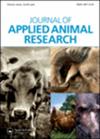巴西固氮螺菌对不同高粱杂交种青贮产量及营养价值的影响
IF 1.3
4区 农林科学
Q3 AGRICULTURE, DAIRY & ANIMAL SCIENCE
引用次数: 1
摘要
本文章由计算机程序翻译,如有差异,请以英文原文为准。
Yield and nutritional value of silage of different sorghum hybrids inoculated with Azospirillum brasilense
ABSTRACT The objective of this study was to evaluate sorghum hybrids associated or not associated with Azospirillum brasilense and nitrogen fertilization (N) during planting on the yield, fermentative profile, and nutritional value of the respective silages. Five sorghum hybrids (Volumax, 201813B, 201814B, 201709B, BRS716) were evaluated with three nitrogen fertilization strategies using urea (100 kg ha−1 of N) and Azospirillum brasilense, and urea (100 kg ha−1 of N)/A. brasilense in association. A randomized block design was used in a 5 × 3 factorial scheme, with five hybrids, three fertilization strategies and three replications (blocks). The useful area of each experimental unit was 3 m x 3 m. The biomass sorghum hybrids showed a dry matter (DM) production (P = 0.01) 48.31% higher than the DM production of the Volumax forage (mean of 17.49 t ha−1 of dry matter). There was no difference between the sorghum hybrid silages in the pH values (mean of 4.11; P = 0.68), gas losses (mean of 3.74% of DM; P = 0.19). The sorghum hybrids biomass 201709B and BRS 716 showed better digestible and DM productivity. Azospirillum brasilense can be used as a nitrogen fertilization strategy in partial or total replacement of urea.
求助全文
通过发布文献求助,成功后即可免费获取论文全文。
去求助
来源期刊

Journal of Applied Animal Research
农林科学-奶制品与动物科学
CiteScore
2.70
自引率
0.00%
发文量
80
审稿时长
6 months
期刊介绍:
Journal of Applied Animal Research (JAAR) is an international open access journal. JAAR publishes articles related to animal production and fundamental aspects of genetics, nutrition, physiology, reproduction, immunology, pathology and animal products. Papers on cows and dairy cattle, small ruminants, horses, pigs and companion animals are very welcome, as well as research involving other farm animals, aquatic and wildlife species. In addition, manuscripts involving research in other species that is directly related to animal production will be considered for publication.
 求助内容:
求助内容: 应助结果提醒方式:
应助结果提醒方式:


